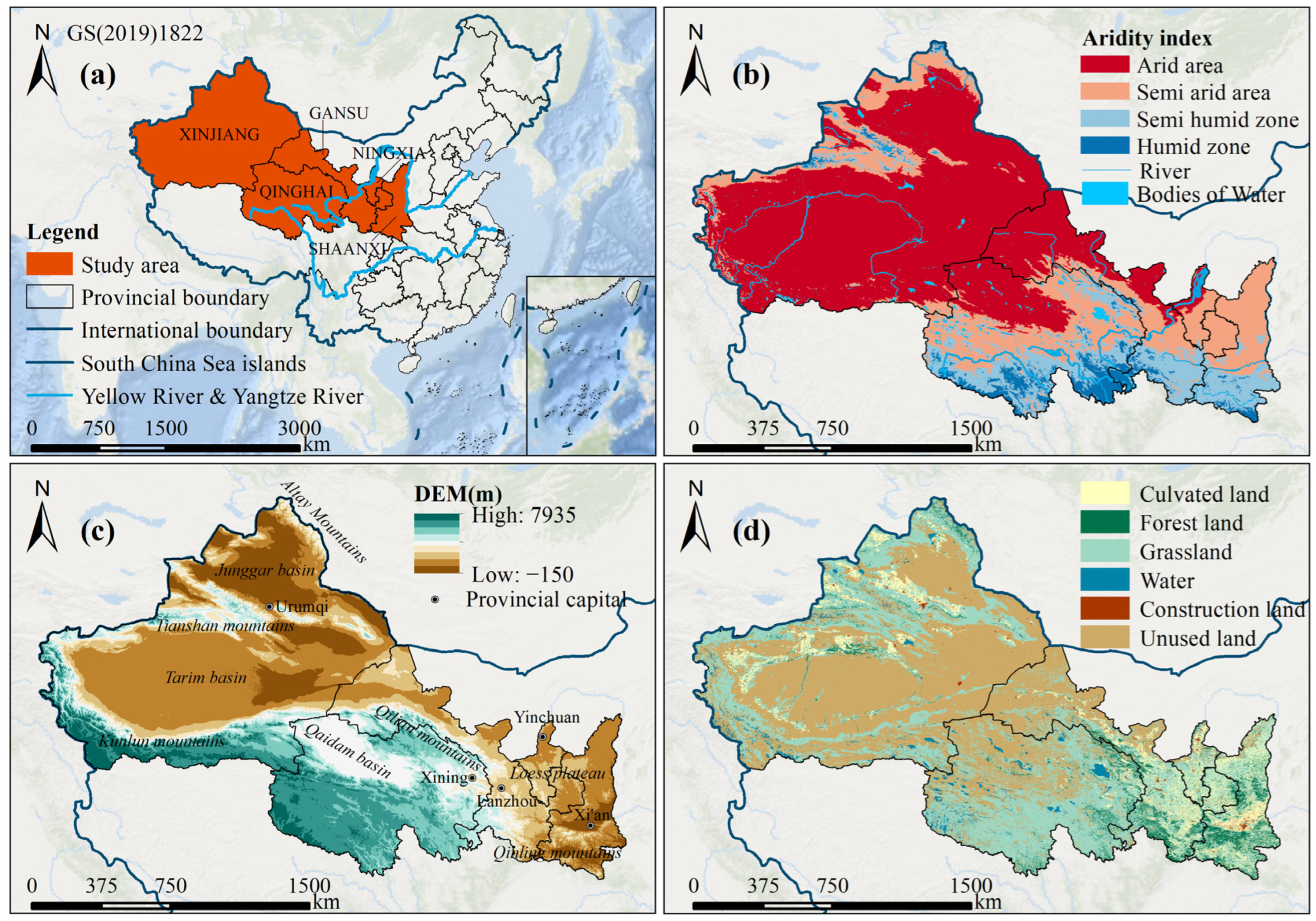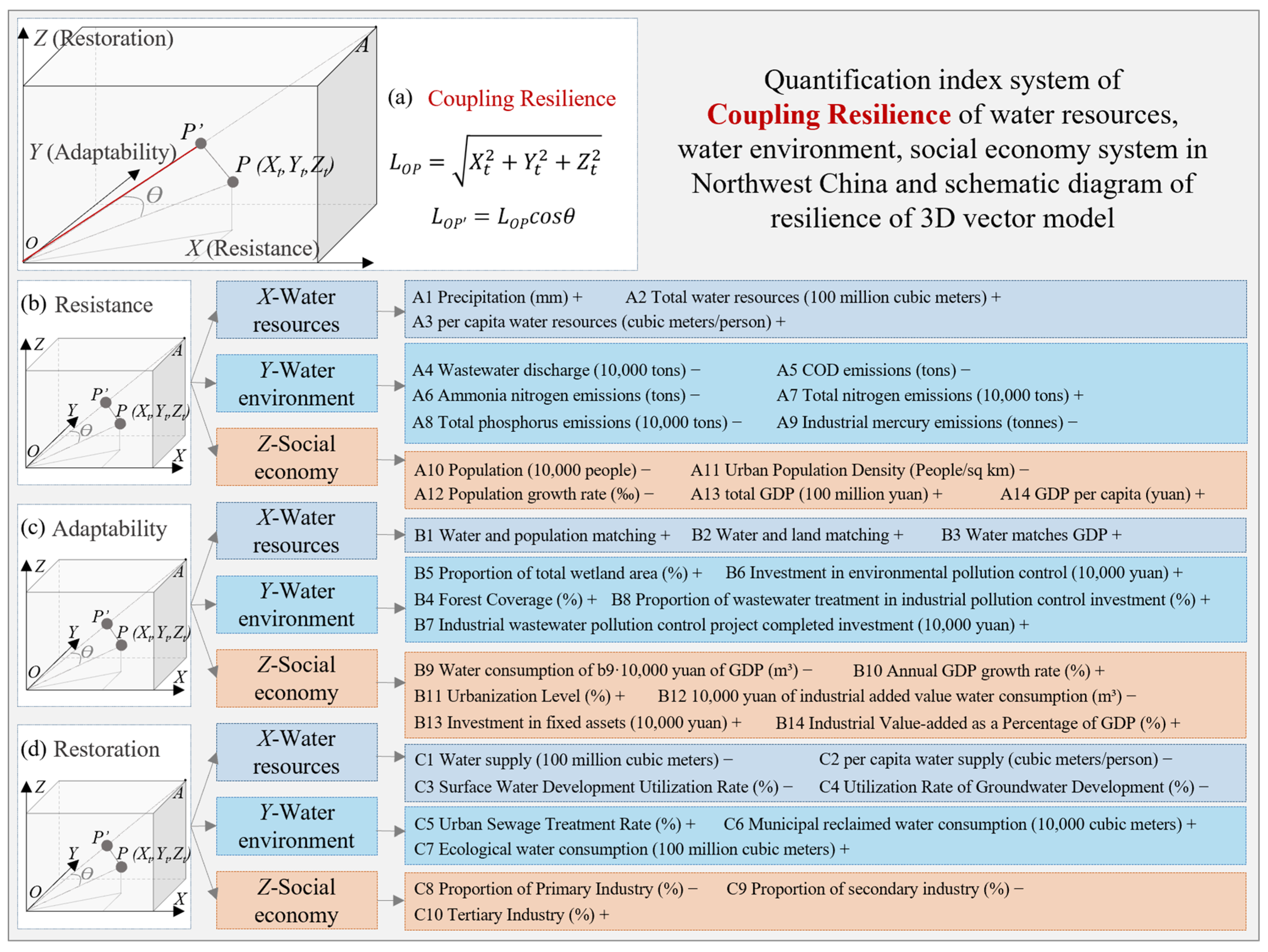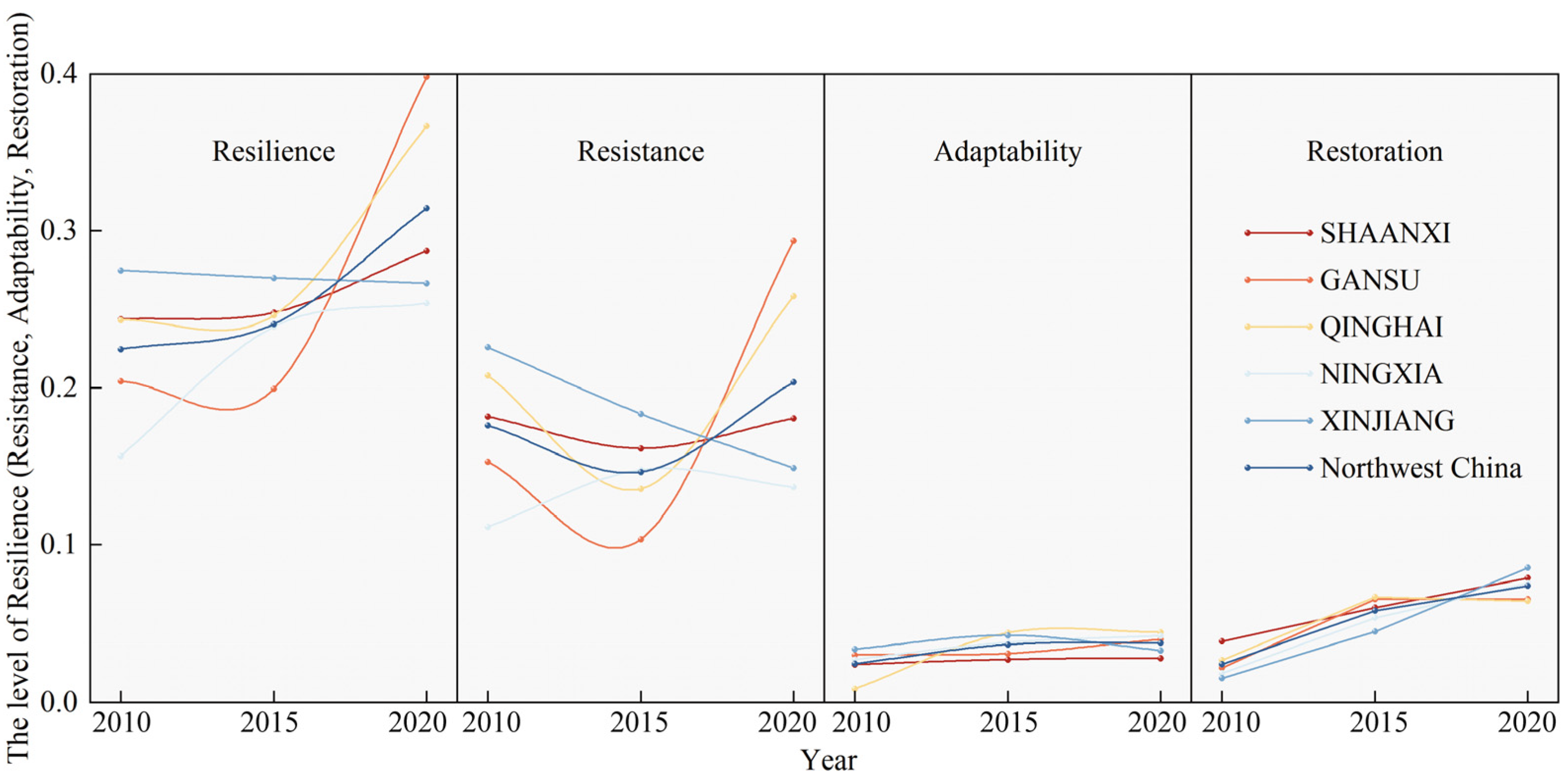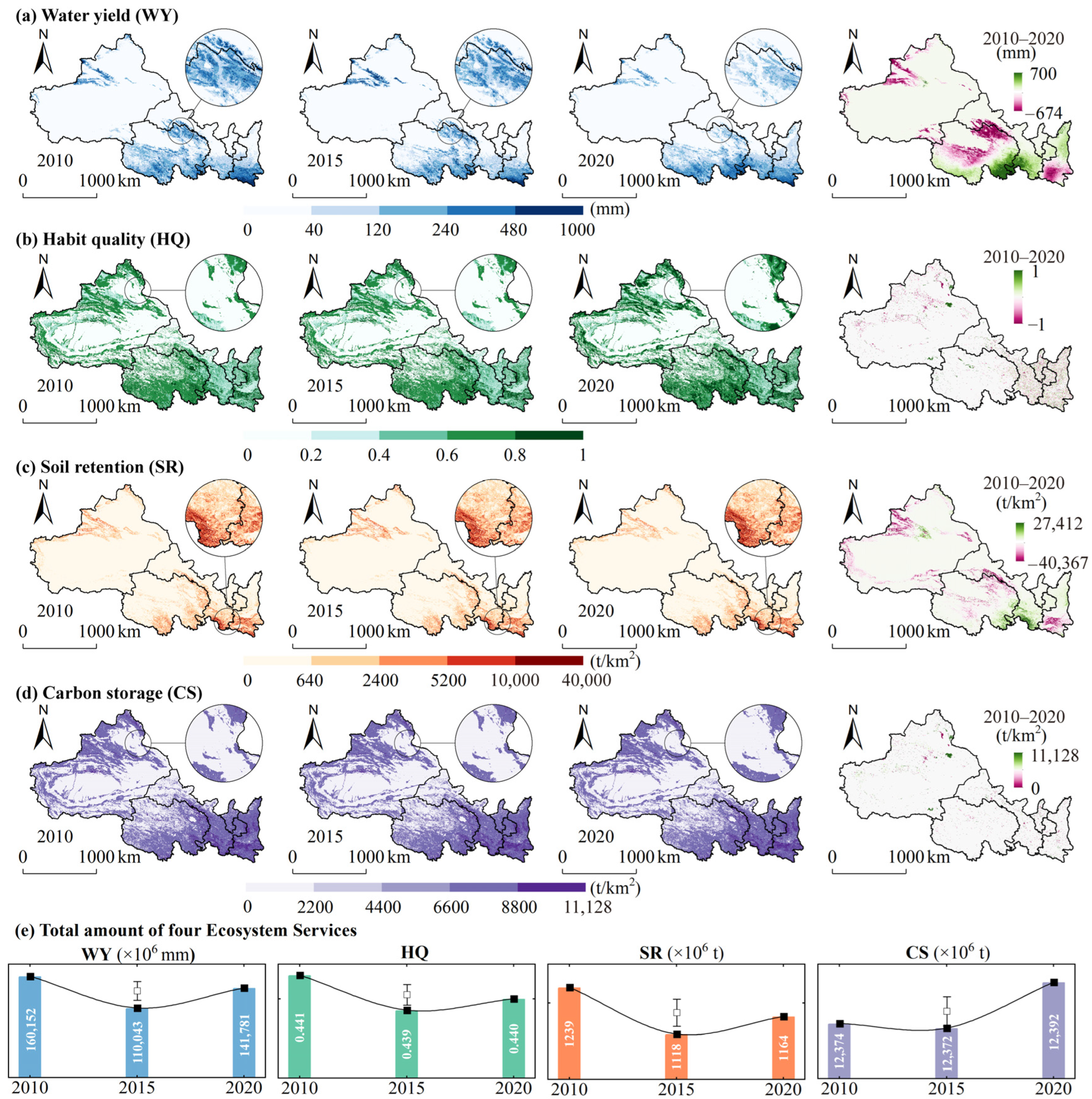Coupling Coordination Relationships Between Water Resource–Water Environment–Social Economy Resilience and Ecosystem Services in Five Provinces of Northwest China
Abstract
:1. Introduction
2. Materials and Methods
2.1. Study Area and Data Sources
2.2. Coupling Analysis Framework for WR-WE-SE and ES
2.3. Quantification of WR-WE-SEr
2.4. Quantification of ESs
2.5. CCD Model
3. Results
3.1. The Trend of WR-WE-SEr
3.2. Spatial and Temporal Characterization of ESs
3.3. Coupling Coordination Degree Between WR-WE-SEr and ESs
4. Discussion
4.1. Interactions of WR-WE-SEr and ESs
4.2. Synergistic Pathways for Systemic Governance and Key Element Management
5. Conclusions
- (1)
- For RQ1 (spatiotemporal evolution patterns), the WR-WE-SEr system exhibited a sustained upward trajectory in resilience over the decade, with significant regional disparities: Qinghai consistently outperformed Xinjiang, Gansu, Shaanxi, and Ningxia. Resistance—the system’s capacity to buffer disturbances—dominated resilience dynamics, while adaptability showed limited variability. Meanwhile, ESs displayed pronounced spatial heterogeneity. WY increased in water-rich regions but declined overall, whereas HQ and CS spatially aligned with vegetation and land cover. Temporally, all ESs followed a distinct “V-shaped” trajectory, marked by an initial decline followed by recovery, with localized fluctuations but regional-scale stability.
- (2)
- Regarding RQ2 (coordinated coupling relationships), the CCD between WR-WE-SEr and ESs revealed hierarchical and spatial patterns. Coordination levels ranked as CS > HQ > WY > SR, reflecting stronger synergies between system resilience and carbon sequestration. Spatially, CCD decreased along a southeast-to-northwest gradient, mirroring ESs’ distribution. Regionally, Shaanxi achieved the highest coordination, followed by Ningxia, Qinghai, Gansu, and Xinjiang. Notably, coordination varied across ES types: extreme misalignment with WY contrasted with improving HQ coordination, moderate SR alignment, and primary CS synergies. While total ESs achieved moderate coordination (0.48 to 0.53), SR-CCD remained chronically dysfunctional (≈0.1) due to persistent soil erosion pressures and limited restoration capacity in arid zones, highlighting the need for targeted soil conservation strategies despite overall system improvements. At the integrated ES level, the system transitioned from dissonance to coordination, indicating gradual optimization of human–nature interactions.
Author Contributions
Funding
Data Availability Statement
Conflicts of Interest
References
- Liu, J.; Dietz, T.; Carpenter, S.R.; Alberti, M.; Folke, C.; Moran, E.; Pell, A.N.; Deadman, P.; Kratz, T.; Lubchenco, J.; et al. Complexity of Coupled Human and Natural Systems. Science 2007, 317, 1513–1516. [Google Scholar] [CrossRef]
- Ostrom, E. A General Framework for Analyzing Sustainability of Social-Ecological Systems. Science 2009, 325, 419–422. [Google Scholar] [CrossRef] [PubMed]
- Conradi, T.; Eggli, U.; Kreft, H.; Schweiger, A.H.; Weigelt, P.; Higgins, S.I. Reassessment of the risks of climate change for terrestrial ecosystems. Nat. Ecol. Evol. 2024, 8, 888–900. [Google Scholar] [CrossRef]
- Huggins, X.; Gleeson, T.; Kummu, M.; Zipper, S.C.; Wada, Y.; Troy, T.J.; Famiglietti, J.S. Hotspots for social and ecological impacts from freshwater stress and storage loss. Nat. Commun. 2022, 13, 439. [Google Scholar] [CrossRef] [PubMed]
- Liao, Y.; Hou, X.-S.; Ren, X.-H. Analysis of the Urban Water Eco-environment Protection Strategy in the Beijing-Tianjin-Hebei Region from “Three Waters” Overall Planning. Huan Jing Ke Xue = Huanjing Kexue 2022, 43, 1853–1862. [Google Scholar] [CrossRef] [PubMed]
- Sun, G.; Hallema, D.; Asbjornsen, H. Ecohydrological processes and ecosystem services in the Anthropocene: A review. Ecol. Process. 2017, 6, 35. [Google Scholar] [CrossRef]
- Zhao, Z.; Wang, H.; Zhang, L.; Liu, X.; Zhao, Y. Construction and application of resilience evaluation model of water resources-water environment-social economy complex system in the Yangtze River Economic Belt. Adv. Water Sci. 2022, 33, 705–717. (In Chinese) [Google Scholar]
- Wang, T.; Jian, S.; Wang, J.; Yan, D. Dynamic interaction of water–economic–social–ecological environment complex system under the framework of water resources carrying capacity. J. Clean. Prod. 2022, 368, 133132. [Google Scholar] [CrossRef]
- Omer, A.; Elagib, N.A.; Zhuguo, M.; Saleem, F.; Mohammed, A. Water scarcity in the Yellow River Basin under future climate change and human activities. Sci. Total Environ. 2020, 749, 141446. [Google Scholar] [CrossRef]
- Dai, D.; Alamanos, A.; Cai, W.; Sun, Q.; Ren, L. Assessing Water Sustainability in Northwest China: Analysis of Water Quantity, Water Quality, Socio-Economic Development and Policy Impacts. Sustainability 2023, 15, 11017. [Google Scholar] [CrossRef]
- Deng, Q.; Sharretts, T.; Ali, T.; Ao, Y.Z.; Chiarelli, D.D.; Demeke, B.; Marston, L.; Mehta, P.; Mekonnen, M.; Rulli, M.C.; et al. Deepening water scarcity in breadbasket nations. Nat. Commun. 2025, 16, 1110. [Google Scholar] [CrossRef] [PubMed]
- Rosa, L.; Sangiorgio, M. Global water gaps under future warming levels. Nat. Commun. 2025, 16, 1192. [Google Scholar] [CrossRef] [PubMed]
- Konapala, G.; Mishra, A.K.; Wada, Y.; Mann, M.E. Climate change will affect global water availability through compounding changes in seasonal precipitation and evaporation. Nat. Commun. 2020, 11, 3044. [Google Scholar] [CrossRef]
- Tzampoglou, P.; Ilia, I.; Karalis, K.; Tsangaratos, P.; Zhao, X.; Chen, W. Selected Worldwide Cases of Land Subsidence Due to Groundwater Withdrawal. Water 2023, 15, 1094. [Google Scholar] [CrossRef]
- Zhang, W.; Ma, L.; Li, H.; Wang, X. Trends in the future evolution of rural settlements in oasis-desert areas under water use simulation scenarios: Take the Hexi Corridor region of China as an example. Landsc. Urban Plan. 2024, 248, 105110. [Google Scholar] [CrossRef]
- Zhang, K.; Dong, Z.; Guo, L.; Boyer, E.W.; Liu, J.; Chen, J.; Fan, B. Coupled coordination spatiotemporal analyses inform sustainable development and environmental protection for the Yellow River Basin of China. Ecol. Indic. 2023, 151, 110283. [Google Scholar] [CrossRef]
- Wang, Y.; Gong, J.; Yang, Z.; Zhu, Y. Social-ecological system research in a changing world: State of the art and future challenges. J. Clean. Prod. 2025, 489, 144725. [Google Scholar] [CrossRef]
- Shi, Y.; Zhai, G.; Xu, L.; Zhou, S.; Lu, Y.; Liu, H.; Huang, W. Assessment methods of urban system resilience: From the perspective of complex adaptive system theory. Cities 2021, 112, 103141. [Google Scholar] [CrossRef]
- Wang, Y.; Wan, F.; Peng, S.; Zheng, X.; Han, W.; Yan, D.; Wang, W.; Zhang, D. Resilience level assessment of regional water resources system based on multi-link. Ecol. Indic. 2024, 160, 111943. [Google Scholar] [CrossRef]
- Hurlimann, A.; Wilson, E. Sustainable Urban Water Management under a Changing Climate: The Role of Spatial Planning. Water 2018, 10, 546. [Google Scholar] [CrossRef]
- Zhang, X.; Tian, C. Measurement and Influencing Factors of Regional Economic Resilience in China. Sustainability 2024, 16, 3338. [Google Scholar] [CrossRef]
- Zhang, L.; Fang, C.; Zhao, R.; Zhu, C.; Guan, J. Spatial–temporal evolution and driving force analysis of eco-quality in urban agglomerations in China. Sci. Total Environ. 2023, 866, 161465. [Google Scholar] [CrossRef]
- Zhu, S.; Li, D.; Feng, H.; Zhang, N. The influencing factors and mechanisms for urban flood resilience in China: From the perspective of social-economic-natural complex ecosystem. Ecol. Indic. 2023, 147, 109959. [Google Scholar] [CrossRef]
- Ma, Y.; Ren, J.; Kang, S.; Niu, J.; Tong, L. Spatial-temporal dynamics of meteorological and agricultural drought in Northwest China: Propagation, drivers and prediction. J. Hydrol. 2025, 650, 132492. [Google Scholar] [CrossRef]
- Ding, J.; Bai, Y.; Yang, X.; Gao, Z. Spatiotemporal Evolution of Water Resource Utilization and Economic Development in the Arid Region of China: A “Matching-Constraint” Perspective. Sustainability 2022, 14, 8724. [Google Scholar] [CrossRef]
- Cui, H.; Zhang, G.; Wang, Q.; Wang, J.; Liu, M.; Yan, M. Study on Index of Groundwater Ecological Function Crisis Classification and Early Warning in Northwest China. Water 2022, 14, 1911. [Google Scholar] [CrossRef]
- Cui, H.; Yan, M.; Wang, Q.; Zhang, G.; Feng, H.; Lang, X. Influencing Factors and Evaluation of Groundwater Ecological Function in Arid/Semiarid Regions of China: A Review. Sustainability 2024, 16, 1631. [Google Scholar] [CrossRef]
- Zhen, N.; Rutherfurd, I.; Webber, M. Ecological water, a new focus of China’s water management. Sci. Total Environ. 2023, 879, 163001. [Google Scholar] [CrossRef]
- He, J.; Pan, Z.; Liu, D.; Guo, X. Exploring the regional differences of ecosystem health and its driving factors in China. Sci. Total Environ. 2019, 673, 553–564. [Google Scholar] [CrossRef]
- Huang, F.; Chunyu, X.; Zhang, D.; Chen, X.; Ochoa, C.G. A framework to assess the impact of ecological water conveyance on groundwater-dependent terrestrial ecosystems in arid inland river basins. Sci. Total Environ. 2020, 709, 136155. [Google Scholar] [CrossRef]
- Shifaw, E.; Sha, J.; Li, X.; Bao, Z.; Ji, J.; Ji, Z.; Kassaye, A.Y.; Lai, S.; Yang, Y. Ecosystem services dynamics and their influencing factors: Synergies/ tradeoffs interactions and implications, the case of upper Blue Nile basin, Ethiopia. Sci. Total Environ. 2024, 938, 173524. [Google Scholar] [CrossRef]
- Shen, W.; Zhang, J.; Wang, K.; Zhang, Z. Identifying the spatio-temporal dynamics of regional ecological risk based on Google Earth Engine: A case study from Loess Plateau, China. Sci. Total Environ. 2023, 873, 162346. [Google Scholar] [CrossRef] [PubMed]
- Liu, J.; Kuang, W.; Zhang, Z.; Xu, X.; Qin, Y.; Ning, J.; Zhou, W.; Zhang, S.; Li, R.; Yan, C.; et al. Spatiotemporal characteristics, patterns, and causes of land-use changes in China since the late 1980s. J. Geogr. Sci. 2014, 24, 195–210. [Google Scholar] [CrossRef]
- Pan, X.; Zhu, L.; Chan, K.T.; Qin, Z.; Guo, E.; Bao, Y.; Qing, S.; Cui, T. Human-induced water loss potentially threatens sustainable development of sandy regions in China. Commun. Earth Environ. 2025, 6, 68. [Google Scholar] [CrossRef]
- Fu, B.; Wu, X.; Wang, Z.; Wu, X.; Wang, S. Coupling human and natural systems for sustainability: Experience from China’s Loess Plateau. Earth Syst. Dyn. 2022, 13, 795–808. [Google Scholar] [CrossRef]
- Cao, M.; Lu, X.; Qin, Z.; Liu, X.; Li, F. Social-ecological system changes in China from 1990 to 2018. Ecol. Indic. 2022, 139, 108926. [Google Scholar]
- Wang, J.; Sun, Y.; Zhao, C.; Yang, Z.; Peng, J. Understanding the evolution of relationships among natural resource, social economy, and eco-environment. Geol. Bull. China 2024, 43, 1289–1296. (In Chinese) [Google Scholar]
- Wang, Z.; Fu, B.; Wu, X.; Wang, S.; Li, Y.; Zhang, L.; Chen, N.; Wu, X. Exploring the interdependencies of ecosystem services and social-ecological factors on the Loess Plateau through network analysis. Sci. Total Environ. 2025, 960, 178362. [Google Scholar] [CrossRef]
- Carpenter, S.; Walker, B.; Abel, A.N. From Metaphor to Measurement: Resilience of What to What? Ecosystems 2001, 4, 765–781. [Google Scholar] [CrossRef]
- Zhang, K.; Fang, B.; Zhang, Z.; Liu, T.; Liu, K. Exploring future ecosystem service changes and key contributing factors from a “past-future-action” perspective: A case study of the Yellow River Basin. Sci. Total Environ. 2024, 926, 171630. [Google Scholar] [CrossRef]
- You, C.; Qu, H.; Guo, L. A framework of composite factors for assessing ecosystem service supply drivers: A sustainable socio-ecological perspective. Ecol. Indic. 2024, 169, 112811. [Google Scholar] [CrossRef]
- Gomes, E.; Inácio, M.; Bogdzevič, K.; Kalinauskas, M.; Karnauskaitė, D.; Pereira, P. Future land-use changes and its impacts on terrestrial ecosystem services: A review. Sci. Total Environ. 2021, 781, 146716. [Google Scholar] [CrossRef]
- Agudelo, C.A.R.; Bustos, S.L.H.; Moreno, C.A.P. Modeling interactions among multiple ecosystem services. A critical review. Ecol. Model. 2020, 429, 109103. [Google Scholar] [CrossRef]
- Liu, H.; Tang, D. Ecological zoning and ecosystem management based on landscape ecological risk and ecosystem services: A case study in the Wuling Mountain Area. Ecol. Indic. 2024, 166, 112421. [Google Scholar] [CrossRef]
- Li, C.; Xu, H.; Du, P.; Tang, F. Predicting land cover changes and carbon stock fluctuations in Fuzhou, China: A deep learning and InVEST approach. Ecol. Indic. 2024, 167, 112658. [Google Scholar] [CrossRef]
- Liang, L.; Zhang, F.; Wu, F.; Chen, Y.; Qin, K. Coupling coordination degree spatial analysis and driving factor between socio-economic and eco-environment in northern China. Ecol. Indic. 2022, 135, 108555. [Google Scholar] [CrossRef]
- Wang, S.-J.; Kong, W.; Ren, L.; Zhi, D.-D.; Dai, B.-T. Research on misuses and modification of coupling coordination degree model in China. J. Nat. Resour. 2021, 36, 793–810. [Google Scholar] [CrossRef]
- Ma, M.; Tang, J. Interactive coercive relationship and spatio-temporal coupling coordination degree between tourism urbanization and eco-environment: A case study in Western China. Ecol. Indic. 2022, 142, 109149. [Google Scholar] [CrossRef]
- Shi, Y.; Feng, C.-C.; Yu, Q.; Han, R.; Guo, L. Contradiction or coordination? The spatiotemporal relationship between landscape ecological risks and urbanization from coupling perspectives in China. J. Clean. Prod. 2022, 363, 132557. [Google Scholar] [CrossRef]
- Rubio-Martin, A.; Pulido-Velazquez, M.; Macian-Sorribes, H.; Garcia-Prats, A. System Dynamics Modeling for Supporting Drought-Oriented Management of the Jucar River System, Spain. Water 2020, 12, 1407. [Google Scholar] [CrossRef]
- Chen, L.; Yu, W.; Zhang, X. Spatio-temporal patterns of High-Quality urbanization development under water resource constraints and their key Drivers: A case study in the Yellow River Basin, China. Ecol. Indic. 2024, 166, 112441. [Google Scholar] [CrossRef]
- Wei, X.; Jones, J.; Hou, Y.; Liu, S.; Asbjornsen, H.; Zhang, Z.; Shah, N.; Wang, Y.; Zhang, M.; Creed, I.; et al. Local considerations are the key to managing global forests for water. Sci. Bull. 2025, 70, 448–451. [Google Scholar] [CrossRef] [PubMed]
- Qian, K.; Ma, X.; Yan, W.; Li, J.; Xu, S.; Liu, Y.; Luo, C.; Yu, W.; Yu, X.; Wang, Y.; et al. Trade-offs and synergies among ecosystem services in Inland River Basins under the influence of ecological water transfer project: A case study on the Tarim River basin. Sci. Total Environ. 2024, 908, 168248. [Google Scholar] [CrossRef] [PubMed]
- Zhang, F.; Xiao, Y.; Gao, L.; Ma, D.; Su, R.; Yang, Q. How agricultural water use efficiency varies in China—A spatial-temporal analysis considering unexpected outputs. Agric. Water Manag. 2022, 260, 107297. [Google Scholar] [CrossRef]
- Lu, J.; Zheng, J.; Jian, P.; Xiao, X.; Li, G.; Liu, L.; Wang, R.; Zhang, J. Spatial and temporal evolution of ecological vulnerability and its response to drought in Xinjiang. Remote Sens. Nat. Resour. 2024, 1–12. (In Chinese) [Google Scholar]
- Gao, M.; Hu, Y.; Liu, X.; Liang, M. Revealing multi-scale characteristics of ecosystem services supply and demand imbalance to enhance refined ecosystem management in China. Ecol. Indic. 2025, 170, 112971. [Google Scholar] [CrossRef]
- O’donnell, M.; Collier, M.; Pineda-Pinto, M.; Cooper, C.; Nulty, F.; Castañeda, N.R. Redefining co-design for social-ecological research and practice: A systematic literature review. Environ. Sci. Policy 2025, 164, 103998. [Google Scholar] [CrossRef]
- Gorobets, A. Eco-centric policy for sustainable development. J. Clean. Prod. 2014, 64, 654–655. [Google Scholar] [CrossRef]
- Wu, B.; Ma, Z.; Feng, X.; Zeng, H.; Gou, S.; Li, H.; Huang, J.; Fu, B. Coordinating red line policies with water consumption caps in China’s drylands. Sci. Bull. 2025; in press. [Google Scholar] [CrossRef]
- Yan, H.; Lin, Y.; Chen, Q.; Zhang, J.; He, S.; Feng, T.; Wang, Z.; Chen, C.; Ding, J. A Review of the Eco-Environmental Impacts of the South-to-North Water Diversion: Implications for Interbasin Water Transfers. Engineering 2023, 30, 161–169. [Google Scholar] [CrossRef]
- Zhang, J.; Wang, M.; Liu, K.; Chen, S.; Zhao, Z. Social-ecological system sustainability in China from the perspective of supply-demand balance for ecosystem services. J. Clean. Prod. 2025, 497, 145039. [Google Scholar] [CrossRef]
- Hu, M.M.; Li, Z.T.; Yuan, M.J.; Fan, C.; Xia, B.C. Spatial differentiation of ecological security and differentiated management of ecological conservation in the Pearl River Delta, China. Ecol. Indic. 2019, 104, 439–448. [Google Scholar] [CrossRef]
- Shen, W.; Li, Y.; Qin, Y. Research on the influencing factors and multi-scale regulatory pathway of ecosystem health: A case study in the Middle Reaches of the Yellow River, China. J. Clean. Prod. 2023, 406, 137038. [Google Scholar] [CrossRef]
- Yang, L.; Liu, Y.; Liu, Y.; Liu, R. Spatial-temporal dynamics and drivers of ecosystem service interactions along the Yellow River area in Shaanxi Province. J. Clean. Prod. 2025, 496, 145095. [Google Scholar] [CrossRef]
- Fu, B.; Liu, Y.; Zhao, W.; Wu, J. The emerging “pattern-process-service-sustainability” paradigm in landscape ecology. Landsc. Ecol. 2025, 40, 54. [Google Scholar] [CrossRef]
- Chen, W.; Chi, G. Urbanization and ecosystem services: The multi-scale spatial spillover effects and spatial variations. Land Use Policy 2022, 114, 105964. [Google Scholar] [CrossRef]
- Li, Y.; Sang, S.; Mote, S.; Rivas, J.; Kalnay, E. Challenges and opportunities for modeling coupled human and natural systems. Natl. Sci. Rev. 2023, 10, nwad054. [Google Scholar] [CrossRef]
- Schirpke, U.; Ghermandi, A.; Sinclair, M.; Van Berkel, D.; Fox, N.; Vargas, L.; Willemen, L. Emerging technologies for assessing ecosystem services: A synthesis of opportunities and challenges. Ecosyst. Serv. 2023, 63, 101558. [Google Scholar] [CrossRef]






| Types | Year | Resolution | Source |
|---|---|---|---|
| Land use/cover (LULC) | 2010, 2015, 2020 | 30 m | https://www.resdc.cn (accessed on 15 October 2024) |
| Digital elevation model (DEM) | 2020 | 30 m | https://www.gscloud.cn (accessed on 16 October 2024) |
| Soil | 2009 | 1 km | http://www.geodata.cn/main (accessed on 23 October 2024) |
| Precipitation (PRE) | 2010, 2015, 2020 | 1 km | http://www.geodata.cn/main (accessed on 24 October 2024) |
| Potential evapotranspiration (PET) | 2010, 2015, 2020 | 1 km | https://data.tpdc.ac.cn (accessed on 2 November 2024) |
| Aridity index (AI) | 2020 | 1 km | https://www.geodata.cn/main (accessed on 30 March 2025) |
| Social economy data | 2011, 2016, 2021 | - | https://data.stats.gov.cn/english/easyquery.htm?cn=E0103 (accessed on 8 October 2024) https://app.gjzwfw.gov.cn/jmopen/webapp/html5/szygbxxcx/index.html (accessed on 2 October 2024) |
Disclaimer/Publisher’s Note: The statements, opinions and data contained in all publications are solely those of the individual author(s) and contributor(s) and not of MDPI and/or the editor(s). MDPI and/or the editor(s) disclaim responsibility for any injury to people or property resulting from any ideas, methods, instructions or products referred to in the content. |
© 2025 by the authors. Licensee MDPI, Basel, Switzerland. This article is an open access article distributed under the terms and conditions of the Creative Commons Attribution (CC BY) license (https://creativecommons.org/licenses/by/4.0/).
Share and Cite
Wang, S.; He, J.; Zhou, Y.; Liu, X. Coupling Coordination Relationships Between Water Resource–Water Environment–Social Economy Resilience and Ecosystem Services in Five Provinces of Northwest China. Water 2025, 17, 1172. https://doi.org/10.3390/w17081172
Wang S, He J, Zhou Y, Liu X. Coupling Coordination Relationships Between Water Resource–Water Environment–Social Economy Resilience and Ecosystem Services in Five Provinces of Northwest China. Water. 2025; 17(8):1172. https://doi.org/10.3390/w17081172
Chicago/Turabian StyleWang, Shoufeng, Jia He, Yuxuan Zhou, and Xueying Liu. 2025. "Coupling Coordination Relationships Between Water Resource–Water Environment–Social Economy Resilience and Ecosystem Services in Five Provinces of Northwest China" Water 17, no. 8: 1172. https://doi.org/10.3390/w17081172
APA StyleWang, S., He, J., Zhou, Y., & Liu, X. (2025). Coupling Coordination Relationships Between Water Resource–Water Environment–Social Economy Resilience and Ecosystem Services in Five Provinces of Northwest China. Water, 17(8), 1172. https://doi.org/10.3390/w17081172





